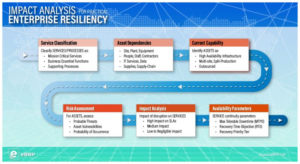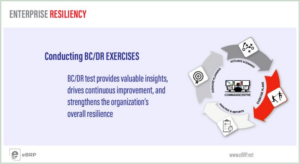As traditional continuity planning becomes inadequate, organizations are increasingly turning to AI technologies for more sophisticated and 𝗮𝗰𝘁𝗶𝗼𝗻𝗮𝗯𝗹𝗲 𝗿𝗲𝘀𝗶𝗹𝗶𝗲𝗻𝗰𝘆 𝘀𝘁𝗿𝗮𝘁𝗲𝗴𝗶𝗲𝘀. AI can transform enterprise resilience by offering deeper insights and enabling faster decision-making during disruptions.
An AI inference sub-system, like eRMA (Enterprise Resiliency Management Assistant) integrated with natural language processing (NLP), allows users to interact using simple prompts without needing extensive training. Imagine asking, “𝘞𝘩𝘢𝘵 𝘢𝘳𝘦 𝘵𝘩𝘦 𝘪𝘮𝘱𝘢𝘤𝘵𝘴 𝘪𝘧 𝘰𝘶𝘳 𝘈𝘵𝘭𝘢𝘯𝘵𝘢 𝘴𝘪𝘵𝘦 𝘨𝘰𝘦𝘴 𝘥𝘰𝘸𝘯?” or “𝘞𝘩𝘰 𝘯𝘦𝘦𝘥𝘴 𝘵𝘰 𝘣𝘦 𝘢𝘭𝘦𝘳𝘵𝘦𝘥 𝘪𝘯 𝘵𝘩𝘦 𝘦𝘷𝘦𝘯𝘵 𝘰𝘧 𝘢 𝘤𝘺𝘣𝘦𝘳 𝘣𝘳𝘦𝘢𝘤𝘩?” and receiving immediate, data-driven responses.
AI’s expert sub-system takes it further by analyzing interdependencies between sites, people, IT services, suppliers, and more. It uses BIA data to predict cascading impacts and helps build tailored response plans. Additionally, real-time risk dashboards, informed by situational awareness, provide dynamic risk mitigation.
This technology 𝗺𝗶𝗻𝗶𝗺𝗶𝘇𝗲𝘀 𝘁𝗵𝗲 𝗹𝗲𝗮𝗿𝗻𝗶𝗻𝗴 𝗰𝘂𝗿𝘃𝗲, enhancing resiliency awareness across all levels—from executives to line managers, auditors, and staff. As remote workforces and complex supply chains become the norm, integrating AI into your resiliency program ensures continuity, regardless of the scale or nature of the disruption.
In moments of crisis, AI empowers executives to make rapid, informed decisions. It can identify root causes, analyze ripple effects, and recommend the best continuity strategies.
AI is not just a tool for continuity—it’s a game-changer for enterprise resiliency.
Request a DEMO of eRMA, the 𝗲𝗕𝗥𝗣 𝗦𝘂𝗶𝘁𝗲 𝗥𝗲𝘀𝗶𝗹𝗶𝗲𝗻𝗰𝘆 𝗣𝗹𝗮𝘁𝗳𝗼𝗿𝗺 𝘄𝗶𝘁𝗵 𝗔𝗜 Integration: https://ebrp.net/request-a-demo/



